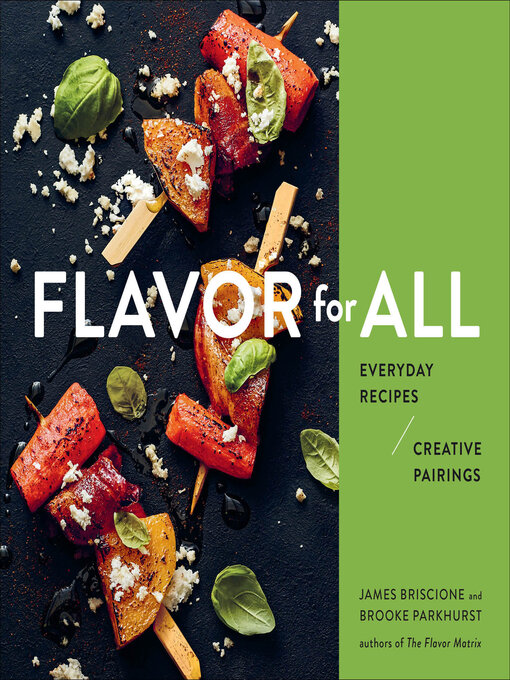Husband-and-wife cookbook authors James Briscione and Brooke Parkhurst introduced the fascinating chemistry of flavor with their innovative volum, The Flavor Matrix. Now they offer 100 new recipes using the same principles and flavor-focused approach in Flavor for All.
This practical home-cooking book features unique and unexpected twists based on scientifically approved flavor pairings. Recipes include Seared Steaks with Almond-Cherry Pesto; Caesar Artichoke Dip; Brown Butter, Maple, and Pear Pork Roast; Spicy Kiwi and Bacon Grilled Cheese Sandwiches; "Umami in a Bottle" salad dressing; and Chocolate and Red Wine Bread Pudding.
Briscione and Parkhurst explain why certain flavors taste so good together and provide plenty of practical tips on how to coax the maximum amount of flavor from your ingredients. This new cookbook will appeal to both chemistry aficionados and casual cooks alike, with simple, easy recipes for everyday life.
-
Creators
-
Publisher
-
Release date
December 15, 2023 -
Formats
-
Kindle Book
-
OverDrive Read
- ISBN: 9780358164029
-
EPUB ebook
- ISBN: 9780358164029
- File size: 45268 KB
-
-
Languages
- English
-
Reviews
-
Publisher's Weekly
September 21, 2020
Husband-wife collaborators Briscione, a two-time Chopped champion, and Parkhurst follow 2018’s The Flavor Matrix with an info-packed recipe collection focused on the fundamentals of flavor pairings. The 100 recipes are divided into categories such as vegetables, land, and sea, each annotated with flavor, taste, and chemical compound notes. For example, the chemistry underlying spicy kiwi and bacon grilled cheese sandwiches relies on the compound 3-carene and the aromas of bell pepper and lemon—as well as resin and rubber—to build flavor. If the scientific annotation proves to be a bit overwhelming, cooks can dive straight into the recipes, which lean toward Briscione’s Southern roots. There’s an unami-rich summer dish that combines clams and squash (compound: dimethylamine) with garlic, basil, and tomatoes. A chianti-braised beef with grits (compound: 2-phenylethanol), meanwhile, has notes of fruit, honey, lilac, and rose. Dessert stars include a decadent chocolate and red wine bread pudding, while cocktails feature temptations like a butternut old-fashioned. Each ingredient also gets labeled with its taste profile: i.e., garlic is umami; Dijon mustard both spicy and acidic; fresh pineapple sweet. Home cooks as curious about what goes on inside the pot as what goes into it will have a ball. Agent: Joy Tutela, David Black Literary Agency. -
Library Journal
October 1, 2020
In this latest collaboration, Briscione and Parkhurst (The Flavor Matrix) promise "no-fail, kick-ass, chemistry-enabled recipes for everyday cooking." With a focus on simplicity and flavor, these recipes are based on the science that makes them work. Flavor-pairing is the goal, with the book serving as a "culinary cheat sheet" to build flavor into every meal. Starting with an Ingredients section that details effective flavor pairing, as well as the role of fat, acid/sour, salt, umami, bitter, sweet in creating a flavor profile, the recipes are divided into Vegetables, Grains and Pasta, Cheese, Land (Chicken, Beef, Pork, Lamb), Sea (Fish; Shrimp, Crab, and Lobster), Drinks, and Baked options. Each section includes tips on mastering relevant ingredients and making the best choices to develop flavor. Each ingredient is labeled along with its corresponding flavor element, making this a unique aspect of the text. VERDICT Flavor pairing adds an exciting twist to familiar ingredients. Recommended as a practical companion to The Flavor Matrix and a worthy introduction for home cooks looking to up their flavor game.--Gricel Dominguez, Florida International Univ. Lib., Miami
Copyright 2020 Library Journal, LLC Used with permission.
-
Booklist
October 1, 2020
Authors of The Flavor Matrix (2018), this husband-and-wife team returns with a cookbook to attract and inspire everyday curious cooks, not just chefs. Briscione and Parkhurst have mastered the science of flavors, exploring the chemistry of those organic compounds that so stimulate human senses. Their study defines flavors as affecting the nose, and taste as occurring on the tongue. Specific chemicals in foods create these sensations, and for each recipe, the authors cite a chemical specific to that recipe's flavor. The science-averse or simply squeamish may be put off by seeing words such as geranylacetone as a component of their food. Recipes themselves can startle, as in a gratin of asparagus and potato chips. Peanut butter cookies get an additional savory boost from fish sauce. Grilled cheese sandwiches add kiwi and bacon. Tired of ordinary pesto? Try the intriguing cherry-almond version they propose. And the truly adventuresome may want to follow the authors' lead and make their own cola. Color photographs help prove Briscione and Parkhurst's points.(Reprinted with permission of Booklist, copyright 2020, American Library Association.)
-
Formats
- Kindle Book
- OverDrive Read
- EPUB ebook
subjects
Languages
- English
Loading
Why is availability limited?
×Availability can change throughout the month based on the library's budget. You can still place a hold on the title, and your hold will be automatically filled as soon as the title is available again.
The Kindle Book format for this title is not supported on:
×Read-along ebook
×The OverDrive Read format of this ebook has professional narration that plays while you read in your browser. Learn more here.



